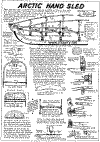By Ben Hunt
This is a picturesque sled and well adapted for winter hikes and overnight camping trips. This sled is not intended for coasting but for hauling only. While it is used as a hand sled in the far north, it is well adapted for one or two dogs.
The runners are made of a hickory or ash sapling, about 1 1/2 in. thick at the butt end. Peel the bark off and rip it through the center. Smooth the cut side with a spokeshave. Then put the two butt ends in a woodworker's vise, one above the other and clamp tightly. Then, slowly work them to the position shown. Green wood will bend easily if worked gradually. Tie a rope around the two runners, and stick a piece of wood under the ends to support them. See Figure 1. If the bending is done in a warm dry place, the wood will be permanently set in a week's time [it is also possible to make the runners out of used skis, which can be found for little or no money].

Fig. 1
In a land where traveling is over snow and
ice for the greatest part of the year, it is only natural that there are many
kinds of sleds. The one described here may be made by any boy, who is willing to
stick on the job, and has sufficient patience.

Fig. 2
Sleds like the one shown, sometimes have runners of wood (Fig. 2) fastened with walrus hide. The top boards are usually 3/8 in. thick and 2 or 3 in. wide, and as lumber is scarce in Eskimo land, they are laid 1/2 to 1 in. apart.
The main thing in making a sled like this is to see that the rawhide fastenings are drawn up as tightly as possible, and that the ends of the lashings are secured. Don't let this type of sled stand out in the rain or dampness unless the rawhide has a good coat of oil or varnish.
